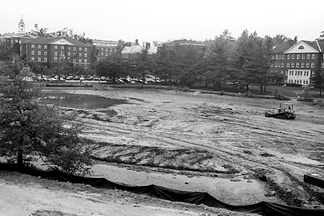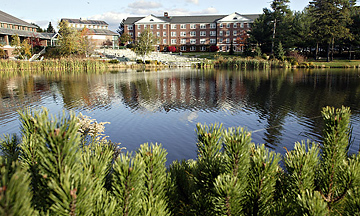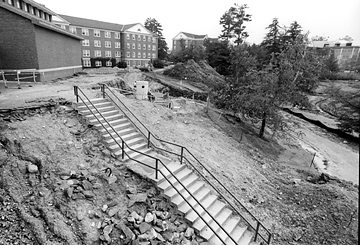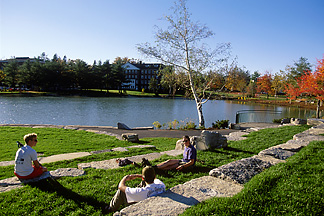July 1998: The Lake Andrews restoration

In July 1998, Bates began a major restoration of the Lake Andrews area. First, the College drained the pond by opening the sluice gate at the south end. Once drained, bulldozers and backhoes removed 4,963 cubic yards of so-called dredge spoils, scraping the bottom to the base of marine clay.
As the water level lowered day by day, all sorts of treasures were revealed: a bowling ball, mangled bike, table, stereo set, desk, bed frame, chairs, tennis shoes, bottles, cans, three 30-pound snapping turtles (they were relocated to a nearby pond) and many overgrown goldfish (contaminated from life in the Puddle, they met their maker).
The College then dumped clean, coarse sand to a depth of six inches. Covering the clay, the sand prevents the water from becoming murky and turbid. Along with the phosphates and other nutrients from runoff, those contaminants had in the past led algae blooms during warm weather.
Lake Andrews was long susceptible to pollution because it is not a “natural pond,” said aquatic biologist and consultant Scott Williams ’71 at the time. A low, wet spot excavated in the 1950s, the pond gets much of its water from stormwater runoff from campus roofs, parking lots and lawns. In the past, too, the occasional “blow downs” from the heating plant boilers would flow into Lake Andrews. “Lake Andrews water doesn’t receive natural filtration that a real pond would from forests, land, and soil,” Williams said in 1998. A new system of drainage pipes will filter the runoff through layers of sand, capturing phosphates and other contaminants.
The final step in the pond restoration project was to stabilize the shoreline. Aquatic and terrestrial vegetation filter undesirable sediments and nutrients in runoff from campus. Some 250 tons of rip-rap (large stones that prevents water erosion) were placed in some areas, vertical stone walls built in others.
The pathway, now named the Marjorie Burgoyne Walkway, was moved back from the shoreline and improved, and an imposing, yet elegant, granite amphitheater now rises from the base of the Olin Arts Center, providing a centerpiece for outdoor events, concerts, and gatherings.
Much of the 1998 Lake Andrews shoreline restoration was funded through a $1-million gift from Henry “Jack” Keigwin ’59 and his wife, Beverly, longtime supporters of projects that improve and enhance the Bates campus. “The Lake Andrews area has a significant potential as a place of respite and rejuvenation,” Jack Keigwin accurately predicted at the time. “It is a place to gather and to celebrate, a place for recreation for the soul and mind.”
More facts about Lake Andrews, Keigwin Amphitheater and Burgoyne Walkway are here.
Material from the Fall 1998 Bates Magazine was used in this story.
– H. Jay Burns, Office of Communications and Media Relations


